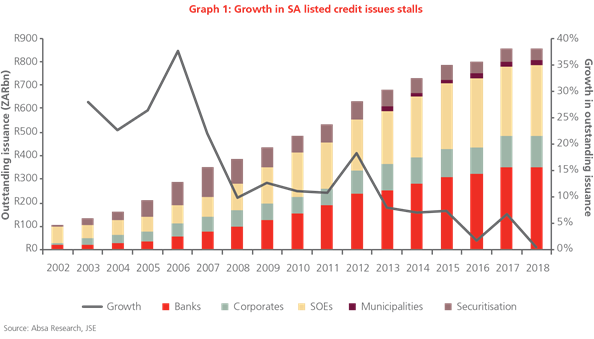A closer look at corporate bonds
At Prudential we have always viewed corporate credit as a core part of our fixed income offering. With a team of dedicated, experienced credit analysts that have access to our parent company M&G’s large team of credit analysts, we have sought to add value to our clients’ portfolios by earning the additional credit risk premium available on corporate bonds. We do this by consistently applying our fundamental credit research process in combination with risk-conscious portfolio construction.
Our ability to invest in domestic corporate bonds is very much a function of issuance (by volume and number of borrowers) in the local listed credit market. This makes up our opportunity set for investing. In the past five years, growth has dwindled in the face of challenges on several fronts. This article looks to place our investments in the context of the key themes that have influenced this trend and to consider where the market finds itself today.
Strong growth curtailed by global financial crisis
Graph 1 reflects the growth in the South African listed credit market over the past 15 years. The local listed credit market has grown from around R105 billion in 2002 to around R857 billion today, a growth rate of roughly 15% per annum. What is clear from the graph though is that this growth has been on a downward trend – the last five years have only seen issuance growing at a pedestrian 5% p.a. Clearly something has changed.

As would be expected in the early years of a market such as ours which was developing in the early 2000s, the rate of growth was elevated as it was starting from a low base. Growth averaged around 25% p.a. in the lead-up to the Global Financial Crisis (GFC) of 2007-2008, driven by growth across the spectrum in issuers and types of credit, but particularly by the volume of securitised assets (bonds backed by pools of assets such as home and auto loans).
This rapid pace of growth fell sharply in the run-up to the GFC – reflecting both the unsustainability of the preceding rapid growth and the increased costs of debt as interest rates rose aggressively. Post-crisis growth flatlined at around 10% p.a., held up by banks and state-owned enterprises (SOEs) who continued to grow their issuance.
However, this was offset by a declining securitisation market tainted by association (rather than any actual problems) with the US sub-prime debt sector which had sparked the financial crisis. Added to this was a corporate market that stalled as issuers baulked at higher financing costs as lenders demanded higher risk premiums for most debt issues.
First defaults
2013 heralded an infamous first for the local corporate market: a default. First Tech, a fairly new issuer which had taken advantage of the increasing demand for corporate credit, collapsed under a cloud of fraud and left investors having to write off almost R1 billion of debt. It was a momentous moment in the local market. Up until this point, local corporate bond investors had experienced a rather charmed investment return package – a higher credit risk premium without any associated defaults!
It goes without saying that there is nothing like a default to focus investors’ minds on risk. Consequently, appetite for corporate debt suffered, and subsequent issuance reflected this. It then took little over a year for the market to experience its second default, and one of considerably larger size and ramifications: African Bank.
African Bank’s default affected almost R15 billion of listed debt – a quantum which not only dwarfed the First Tech default, but also affected a far greater number of funds and investment managers. It was a watershed moment in the local market as managers grappled with the fallout and issuers contemplated lower demand and increased cost of issuance. The hangover was felt in subsequent years.
Rising debt problems
The First Tech and African Bank defaults heralded a new phase in the local corporate market as a number of other issuers subsequently experienced “problems”, no doubt a reflection of the challenging economic circumstances affecting the South African economy. Real People Investment Holdings (unsecured lending) and Basil Read (construction) both defaulted, choosing to de-list their debt prior to default. A number of other issuers breached covenants (the terms governing debt issues) and were forced to either redeem their bonds or restructure their outstanding issuance: PPC, Adcorp, Eqstra and most recently the Consolidated Infrastructure Group, all had their debt affected in one manner or another.
A number of these companies had exposure to infrastructure expenditure (or rather the lack thereof). Borrowers in the construction sector such as Group 5 and Aveng found little investor appetite for their debt given the headwinds facing the sector. There were also some “narrow misses” over this period where local investors managed to avoid losses. Steinhoff narrowly avoided a possible default early this year when the company opted to redeem all R8 billion of its outstanding local debt, a similar outcome to those investors in Edcon’s local issuance in 2016.
In both cases investors in these companies’ local rand-listed debt were redeemed in full, while investors in their offshore debt were subject to restructuring and accompanying losses – fortunately the local debt included some additional protections versus the offshore debt.
SOE woes add to poor investor sentiment
As has been described above, the last five years has seen defaults and redemptions of a number of debt instruments, all of which have curbed issuance volumes and affected both investor and issuer sentiment. Against this backdrop it is understandable why it has been challenging for the corporate credit market to grow. Add to this an SOE sector plagued by the revelations around “State Capture” and the associated governance failings, and one could conclude that it is no small feat that the market has actually managed to eke out any growth!
Previously large-volume issuers like Eskom and Transnet, amongst others, have been unable to borrow (at least certainly not in any size) for some time as investors have avoided association with them. While their governance issues are now being addressed, these issuers have still been unable to return to the local debt market in any meaningful size. In addition to the SOEs, many corporates have adopted a cautious approach toward borrowing given the economic headwinds facing the local economy. In fact, the graph reflects near-zero growth so far in 2018.
Against the odds, liquidity improving
Arguably the one aspect of our listed corporate bond market which has seen some improvement is liquidity. Due to regulatory changes following the GFC, local banks have become greater participants on the buy side of the market. They now have a regulatory incentive to purchase the listed debt of a number of highly rated companies, creating a more diversified investor base across those issuers that is positive for market liquidity.
In addition, a number of financial institutions have created trading desks for local listed debt (presumably given they are now holding more of the asset class), which has aided both liquidity and price discovery. This is not to say the market is liquid – far from it – but certainly there has been an improvement in this regard.
A side-effect of having more demand in a slow-growing market has been more competition for highly rated borrowers. Sought-after companies have been able to issue debt at ever-lower credit risk premiums, curtailing returns available for investors to some extent.
Value of in-depth credit analysis affirmed
As we approach the end of 2018 it’s fair to say that the last five years have been the most eventful the local market has seen. If there was any previous doubt about the value of detailed, fundamental credit research, this period has certainly answered that in no uncertain terms. In-depth analysis is essential in today’s market when defaults are an unfortunate reality, and investors like banks and asset managers are competing for a slow-growing asset class. Looking ahead, the catalyst to increased debt issuance in the local market is undoubtedly increased economic activity, but in the short term this appears challenging.
At Prudential our analysis seeks to protect our clients from the country’s worsening corporate default experience, while also adding value to portfolio returns. We will continue to look to invest in corporate bonds on the back of a carefully considered credit risk assessment process and appropriately priced credit risk premiums. Although issuance remains subdued, there are still investment opportunities available. Like other local investors, we look forward to the day issuance picks up and more corporates decide to borrow in our listed debt market.
To find out more, speak to your financial adviser or contact our Client Services Team on 0860 105 775 or at query@prudential.co.za.
Share
Did you enjoy this article?
 South Africa
South Africa Namibia
Namibia




 Get the Newsletter
Get the Newsletter